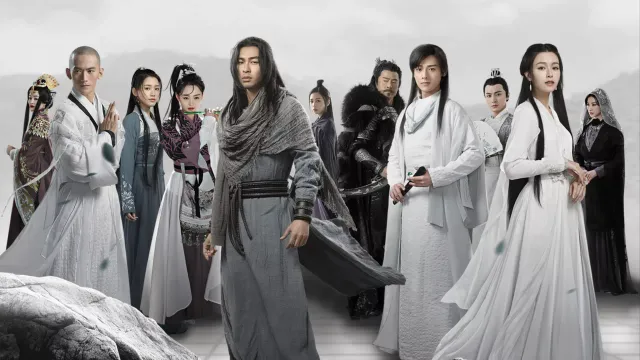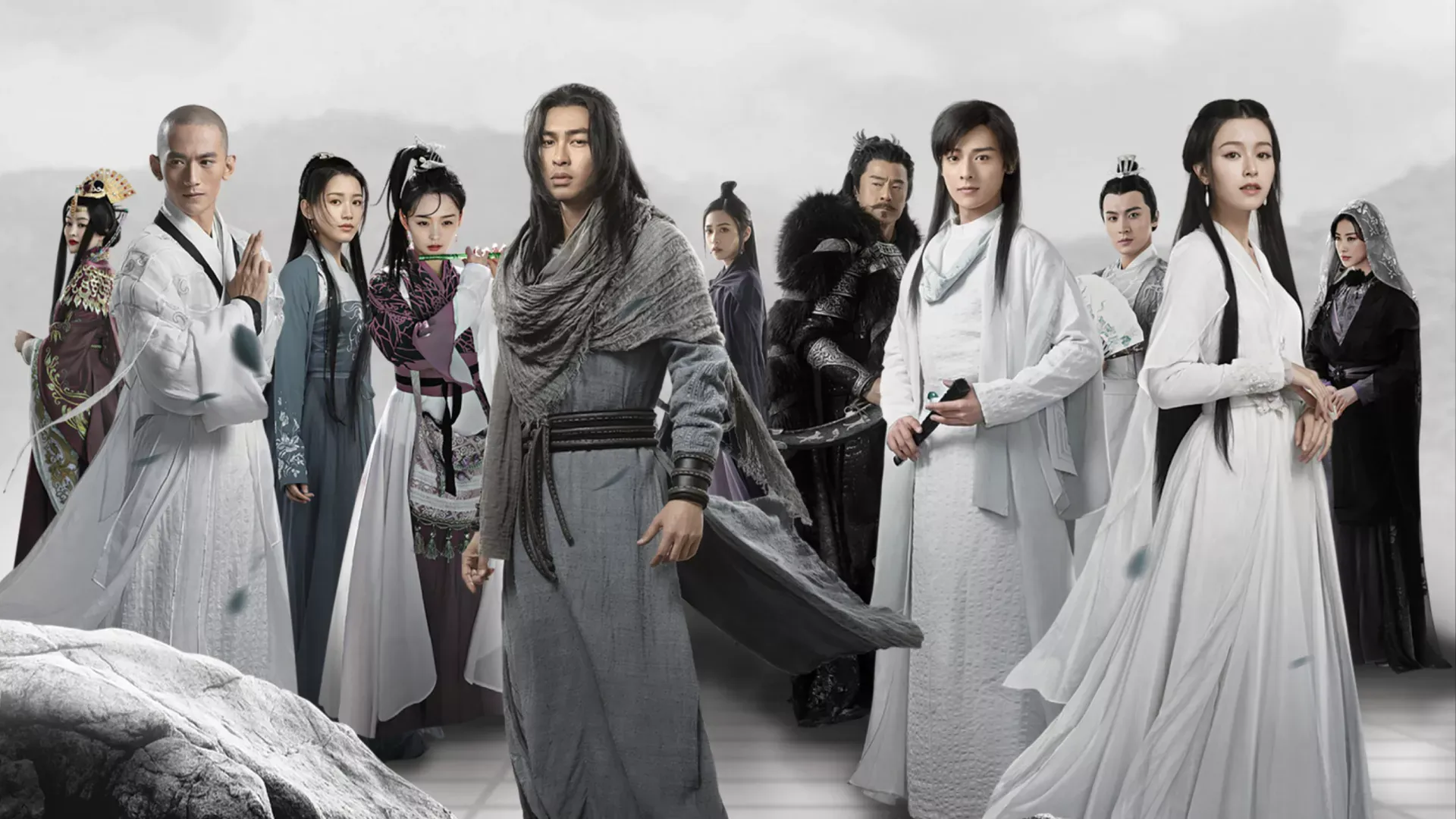Wuliang Sword School (simplified: 无量剑派, traditional: 無量劍派, pinyin: Wúliàng Jiàn Pài) was a martial arts faction based on Mount Wuliang1 in the Dali Kingdom.2 The school was known for its sword techniques and the mysterious Wuliang Jade Wall that was said to reflect images of sword immortals practicing their techniques.
History
Foundation
The Wuliang Sword School was founded during the Later Tang period3 of the Five Dynasties4 on Mount Wuliang in the former Nanzhao Kingdom.5 The school’s headquarters was located at Sword Lake Palace on the mountain, where the faction leader resided.
Division into factions
During the Northern Song period, the school divided into three factions: Eastern, Western, and Northern. Every five years, disciples from the three factions would compete in sword duels at Jianhu Palace, with the winning faction gaining the right to reside there for five years.
The Northern Sect won the competition forty years before the events of the novel and resided in Jianhu Palace for five years. After losing the following competition, the Northern Sect’s leader led his disciples to Shanxi in anger and ceased participating in the sword competitions, cutting off all contact with the Eastern and Western factions.
Over the next thirty-five years, the Eastern and Western factions competed against each other, with the Eastern Branch winning four times and the Western Branch winning twice. Each competition consisted of five sword duels, with the first faction to win three duels being declared the winner.
Organisation
Leadership structure
The school was divided into two active factions, each with their own leader:
Eastern Faction:
- Zuo Zimu (左子穆 – Zuǒ Zǐmù) - Zhangmen of the Eastern Faction
- Rong Ziju (容子矩 – Róng Zǐjǔ) - Zuo Zimu’s shidi
- Gong Guangjie (龚光杰 – Gōng Guāngjié) - Zuo Zimu’s disciple
- Gan Guanghao (干光豪 – Gān Guāngháo) - Zuo Zimu’s disciple
Western Faction:
- Xin Shuangqing (辛双清 – Xīn Shuāngqīng) - Zhangmen of the Western Faction
- Ge Guangpei (葛光佩 – Gě Guāngpèi) - Xin Shuangqing’s disciple
Competition system
The school’s unique competition system determined which faction could reside in Sword Lake Palace. Every five years, the two factions would hold sword duels, with the first to win three out of five matches gaining the right to live in the palace for the next five years.
Before each competition, the leaders of both factions would invite members of other factions to serve as witnesses and guests. The system created intense rivalry between the factions, with the losing faction working hard to improve their techniques for the next competition.
Martial arts abilities
Wuliang Swordplay
The school’s signature technique, Wuliang Swordplay (无量剑法 – Wúliàng Jiànfǎ), was a comprehensive sword system that had been continuously refined and improved over generations. The technique was inspired by the mysterious images reflected in the Wuliang Jade Wall, which showed male and female sword immortals practicing their techniques.
Golden Needle’s Salvation
Golden Needle’s Salvation (金针渡劫 – Jīnzhēn Dùjié) was a technique used by Zuo Zimu when attempting to kill the Lightning Marten. This technique demonstrated the school’s ability to adapt their sword techniques for various combat situations.
Wuliang Sword Formation
Wuliang Sword Formation (无量剑阵 – Wúliàng Jiànzhèn) was a coordinated group technique that allowed multiple disciples to fight together effectively.
Other techniques
The school’s disciples also practiced various sword techniques including:
- Falling Step (跌扑步 – Diēpū Bù)
- White Rainbow Piercing the Sun (白虹贯日 – Báihóng Guànrì)
- Ten Thousand Flowers Competing in Beauty (万卉争艳 – Wànhùi Zhēngyàn)
- Following the Current (顺水推舟 – Shùnshuǐ Tuīzhōu)
Notable members
Zuo Zimu
Zuo Zimu (左子穆 – Zuǒ Zǐmù) was the leader of the Eastern Faction, aged between 40-60 years old with a long beard. His martial arts were considered competent, and he was known for his leadership of the Eastern Faction during the faction’s conflicts with the Shennong Guild.
Xin Shuangqing
Xin Shuangqing (辛双清 – Xīn Shuāngqīng) was the leader of the Western Faction. She led her faction in the regular sword competitions against the Eastern Faction and managed the Western Faction’s affairs.
Gan Guanghao
Gan Guanghao (干光豪 – Gān Guāngháo) was a disciple of the Eastern Faction who developed romantic feelings for Ge Guangpei, a disciple of the Western Faction. During a sword duel, he pretended to have insufficient internal energy and lost to Ge Guangpei. Later, during the faction’s crisis, the two attempted to escape together and planned to kill Duan Yu to silence him, but were killed by Mu Wanqing.
Relationships
Conflicts with Shennong Guild
The Wuliang Sword School had a bitter conflict with the Shennong Guild that ultimately led to the school’s downfall. The conflict began when four Shennong Guild leaders came to Sword Lake Palace requesting permission to gather herbs from the back mountain, which violated the school’s taboos. A fight broke out, and Zuo Zimu and Rong Ziju killed two of the guild members, creating lasting enmity.
The Shennong Guild leader Sikong Xuan had already been controlled by the Mark of Life and Death and was under orders from Lingjiu Palace to occupy Sword Lake Palace and investigate the truth about the Wuliang Jade Wall. This made the conflict inevitable.
The Shennong Guild’s expertise in poison techniques gave them a significant advantage over the Wuliang Sword School, which had no knowledge of poison arts. This imbalance ultimately led to the school’s defeat and their absorption into Lingjiu Palace’s network.
Alliance with Lingjiu Palace
After their conflict with the Shennong Guild, the Wuliang Sword School was absorbed into the Lingjiu Palace network and renamed “Wuliang Cave” (无量洞 – Wúliàng Dòng). This marked the end of the school’s independence and their integration into the larger martial arts world controlled by the Tianshan Child Granny.
Locations
Mount Wuliang
Mount Wuliang (无量山 – Wúliàng Shān) was the school’s primary base, located in the Dali Kingdom. The mountain was known for its scenic beauty and the mysterious Wuliang Jade Wall that inspired the school’s sword techniques.
Sword Lake Palace
Sword Lake Palace (剑湖宫 – Jiànhú Gōng) was the school’s main residence and headquarters. The palace was the site of the regular sword competitions between the factions and served as the residence for the winning faction’s leader.
Behind the scenes
Historical foundation
The Wuliang Sword School draws from the historical significance of Mount Wuliang in Yunnan province. Scholar Chen Wei notes that “Mount Wuliang has been associated with immortal cultivation and mystical practices in Chinese folklore, making it a natural setting for a martial arts school with supernatural elements.”6 The school’s Wuliang Jade Wall reflects traditional Chinese concepts of xian jing (仙境) - immortal realms where divine knowledge is revealed.
Literary function
The Wuliang Sword School serves as Jin Yong’s exploration of how smaller martial arts factions could be absorbed into larger power structures. Literary critic Wang Ming observes that “the school’s internal conflicts and eventual absorption by Lingjiu Palace demonstrate how local martial arts disputes could escalate into major political conflicts.”7 The school’s dual nature (both North and South factions) reflects the historical tendency of martial arts organisations to splinter along ideological or geographical lines.
Cultural context
The school’s competition system for Sword Lake Palace residence reflects traditional Chinese concepts of bi wu (比武) - martial competitions to determine leadership and status. Scholar Li Jing notes that “the school’s use of regular competitions to allocate resources demonstrates how martial arts organisations could institutionalize conflict resolution while maintaining group cohesion.”8
Adaptation history
The Wuliang Sword School has appeared in various adaptations with different emphasis on their internal conflicts vs. their mystical elements. The 2003 television adaptation emphasized the supernatural aspects of the Wuliang Jade Wall, while the 2013 version focused more on the political dynamics between the North and South factions.
See also
- Jin Yong factions
- Demi-Gods and Semi-Devils factions
- Zuo Zimu – Eastern Faction leader
- Xin Shuangqing – Western Faction leader
- Wuliang Swordplay – The school’s signature technique
- Shennong Guild – The faction that defeated the school
- Lingjiu Palace – The faction that absorbed the school
External links
- Mount Wuliang (Chinese) on Chinese Wikipedia
Footnotes
-
无量山 – Wúliàng Shān. Mountain in Yunnan Province, known for its scenic beauty and the Wuliang Jade Wall. ↩
-
大理国 – Dàlǐ Guó. Kingdom in southwest China, modern-day Yunnan, ruled by the Bai people of the Duan Clan from 937 to 1253 CE. See Wikipedia. ↩
-
后唐 – Hòu Táng. Second of the Five Dynasties, lasting from 923 to 936 CE. See Wikipedia. ↩
-
五代十国 – Wǔdài Shíguó. Period of political upheaval in China from 907 to 960/979 CE following the fall of the Tang dynasty. See Wikipedia. ↩
-
南诏 – Nánzhào. Kingdom that existed in Yunnan from 738 to 902 CE, predecessor to the Dali Kingdom. See Wikipedia. ↩
-
Chen Wei, “Sacred Mountains in Yunnan Literature,” Cultural Studies 32, no. 3 (2012): 156-178. ↩
-
Wang Ming, “Power Dynamics in Martial Arts Organizations,” Chinese Literature Studies 38, no. 2 (2013): 89-112. ↩
-
Li Jing, “Competition Systems in Chinese Culture,” Philosophy East and West 43, no. 1 (2014): 234-256. ↩


